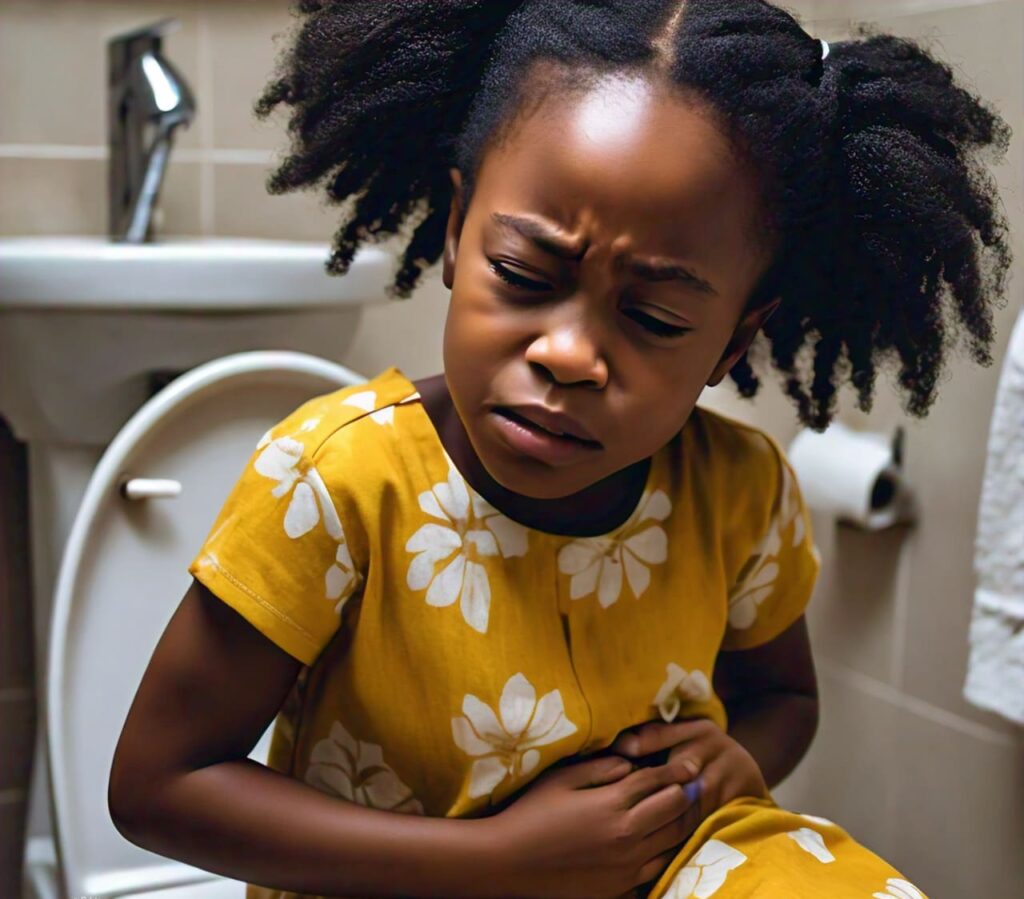
Typhoid fever is a dangerous disease that affects many children in Nigeria every year. This illness can make children very sick and can even be life-threatening if not treated properly.
It’s important for parents and caregivers to know what causes typhoid fever, what symptoms to look out for, and how it can impact a child’s health and daily life.
By understanding more about typhoid fever, we can better protect our children and help them recover quickly if they do get sick. This article will explain everything you need to know about typhoid fever, including both medical and traditional ways to treat it.
What is Typhoid Fever?
Typhoid fever is an infection caused by bacteria called Salmonella Typhi. It spreads through contaminated food and water. Children are especially vulnerable to this illness.
How Do Children Get Typhoid?
- Contaminated Water: Drinking water that contains the bacteria.
- Contaminated Food: Eating food prepared with dirty hands or utensils.
- Poor Sanitation: Living in areas with poor sewage and waste disposal systems.
- Close Contact: Being in close contact with someone who has typhoid fever.
Additional Avenues of Typhoid Fever Transmission
- Dirty Hands: Not washing hands properly after using the toilet can spread the bacteria. When children touch their mouths with dirty hands, they can get infected.
- Flies: Flies can carry the bacteria from dirty places to food and water. When children eat or drink contaminated food or water, they can get typhoid fever.
- Raw Vegetables and Fruits: Eating raw vegetables and fruits that are not washed properly can cause infection. The bacteria can stick to the surface and enter the body when eaten.
- Unpasteurized Milk: Drinking milk that hasn’t been pasteurized (heated to kill bacteria) can also spread typhoid fever. Children are especially vulnerable to infections from unpasteurized milk.
- Street Food: Eating street food from vendors who do not follow proper hygiene practices can be risky. The food might be prepared in unsanitary conditions, leading to contamination.
- Improper Waste Disposal: Living near areas where waste is not properly disposed of can increase the risk. The bacteria can spread from waste to water and food sources.
- Infected Household Items: Using household items, like towels or utensils, that have been used by someone with typhoid fever can spread the bacteria to children.
Symptoms of Typhoid Fever

It can be hard to know if a child has typhoid fever because the symptoms are like other sicknesses.
Children with typhoid fever may show the following symptoms:
- High Fever: A persistent fever that can go up to 104°F (40°C).
- Weakness: Feeling very weak and tired.
- Stomach Pain: Severe pain in the stomach area.
- Headache: Frequent and intense headaches.
- Loss of Appetite: Not wanting to eat, which can lead to weight loss.
- Diarrhea or Constipation: Irregular bowel movements.
- Rash: Small, red spots on the skin.
Effects on Health and Wellbeing
Typhoid fever can have serious effects on a child’s health and overall wellbeing:
- Nutritional Deficiencies: Loss of appetite can lead to malnutrition.
- Weak Immune System: The illness can weaken the immune system, making the child more susceptible to other infections.
- Organ Damage: Severe cases of typhoid fever can cause damage to organs like the liver and spleen.
- Poor Academic Performance: Frequent illness can affect school attendance and learning.
Additional Adverse Effects of Typhoid Fever
- Chronic Fatigue: Children with typhoid fever often feel very tired and have low energy levels, making it hard for them to play and participate in daily activities.
- Dehydration: High fever and diarrhea can lead to severe dehydration. This can be dangerous if not treated promptly.
- Mental Health Issues: Prolonged illness can cause anxiety, stress, and depression in children. They may worry about their health and feel isolated from their friends and school.
- Growth Delay: Chronic illness can slow down a child’s physical growth and development. This can result in being shorter or smaller than their peers.
- Joint Pain: Some children with typhoid fever experience pain in their joints, which can limit their movement and make physical activities difficult.
- Respiratory Problems: In some cases, typhoid fever can cause respiratory issues, making it hard for children to breathe normally.
- Skin Infections: The bacteria can sometimes cause skin infections, leading to sores and rashes.
Stages of Typhoid Fever
Typhoid fever progresses through several stages. Knowing these stages can help parents and caregivers recognize the illness early and get the right treatment.
Stage 1: Early Symptoms (First Week)
- Fever: The fever starts low and gets higher each day.
- Headache: Children may have constant headaches.
- Weakness: They feel very tired and weak.
- Loss of Appetite: They don’t feel like eating.
- Stomach Pain: Mild pain in the stomach starts.
Stage 2: Severe Symptoms (Second Week)
- High Fever: The fever becomes very high, up to 104°F (40°C).
- Severe Weakness: Extreme tiredness and weakness.
- Severe Stomach Pain: Intense pain in the stomach area.
- Diarrhea or Constipation: Irregular bowel movements, either frequent diarrhea or constipation.
- Rash: Small red spots appear on the chest and abdomen.
- Mental Changes: Children might seem confused or act strangely.
Stage 3: Complications (Third Week)
- Ongoing High Fever: The fever remains very high.
- Increased Weakness: Continued severe weakness.
- Risk of Complications: Danger of serious issues like bleeding in the intestines or a hole in the intestine, which can be life-threatening.
- Dehydration: Severe dehydration due to fever and diarrhea.
- Worsening Mental State: Increased confusion and delirium.
Stage 4: Recovery (Fourth Week and Beyond)
- Gradual Improvement: Symptoms start to get better with treatment.
- Fever Decreases: The fever slowly goes down.
- Appetite Returns: Children start to feel hungry again.
- Energy Levels Improve: They begin to regain strength and energy.
- Full Recovery: With continued care, children fully recover. Follow-up visits to the doctor are important to make sure they don’t get sick again.
Medical Treatment for Typhoid Fever
- Antibiotics: Doctors prescribe antibiotics to kill the bacteria. It’s important to complete the full course of medication.
- Hydration: Keeping the child hydrated with clean water or oral rehydration solutions.
- Rest: Ensuring the child gets plenty of rest to help the body recover.
- Hospitalization: In severe cases, the child may need to be hospitalized for more intensive treatment.
Additional Medical Treatments for Typhoid Fever
- Fever Reducers: Medications like paracetamol or ibuprofen can help lower high fevers and make the child more comfortable.
- Nutritional Support: Providing a balanced diet with easily digestible foods can help restore lost nutrients. In severe cases, nutritional supplements may be necessary.
- Probiotics: Giving probiotics can help restore the balance of good bacteria in the gut, which can be disrupted by both the infection and antibiotics.
- Blood Tests: Regular blood tests can help monitor the child’s progress and ensure that the treatment is working effectively.
- Monitoring Vital Signs: Keeping a close watch on the child’s vital signs, such as temperature, heart rate, and blood pressure, to detect any complications early.
- Pain Relief: Providing pain relief medications can help manage symptoms like stomach pain and headaches.
- Follow-Up Care: After initial treatment, follow-up visits to the doctor are crucial to ensure the child has fully recovered and to prevent any relapse.
Traditional Treatment for Typhoid Fever
In addition to medical treatment, some traditional methods may help:
- Herbal Remedies: Some use herbal teas made from neem leaves or guava leaves, which are believed to have medicinal properties.
- Papaya Leaf Juice: Some believe that juice extracted from papaya leaves can help reduce fever.
- Garlic: Consuming garlic is thought to boost the immune system and fight infection.
- Bitter Leaf Juice: Bitter leaf juice is another traditional remedy that some believe can help treat typhoid fever.
Important Considerations
- Consult a Healthcare Professional: Always talk to a doctor before using traditional remedies for children. Some herbal treatments can interact with medications or have side effects.
- Dosage and Safety: Ensure that any traditional treatment is used in safe and appropriate amounts. Children’s bodies are more sensitive, and proper dosing is crucial.
- Complementary Use: Traditional remedies should not replace medical treatments. They should be used as complementary measures, not substitutes for antibiotics or other prescribed treatments.
- Allergic Reactions: Monitor for any adverse reactions when introducing new remedies, and stop use if any negative symptoms occur.
Preventing Typhoid Fever in Children

Preventing typhoid fever in children is crucial for their health and wellbeing.
To help prevent typhoid fever, you can:
- Clean Water: Ensure access to clean, safe drinking water.
- Good Hygiene: Teach children to wash their hands properly with soap and water.
- Safe Food: Make sure food is prepared in clean conditions and properly cooked.
- Vaccination: There are vaccines available to help prevent typhoid fever.
Additional Ways to Prevent Typhoid Fever
- Boil Water: Boil drinking water to kill any harmful bacteria. Even if water looks clean, boiling it ensures it is safe.
- Avoid Street Food: Be cautious with street food, as it may be prepared in unsanitary conditions. Prefer food cooked at home or from trusted sources.
- Wash Fruits and Vegetables: Always wash fruits and vegetables with clean water before eating them. This removes any bacteria on their surface.
- Proper Waste Disposal: Dispose of waste properly to avoid contamination. Teach children to throw waste in designated bins.
- Clean Utensils: Use clean utensils and kitchenware when preparing and serving food. Ensure that plates, cups, and cutlery are thoroughly washed.
- Personal Hygiene: Encourage children to keep their nails trimmed and clean to prevent bacteria from accumulating.
- Avoid Raw Milk: Do not give children unpasteurized (raw) milk. Always ensure milk is pasteurized to kill harmful bacteria.
By taking these steps, you can help protect your child from getting typhoid fever.
Conclusion
Typhoid fever is a serious illness that can significantly affect the health and wellbeing of Nigerian children. Knowing the causes, symptoms, and treatments can help in managing and preventing this disease. While medical treatment is crucial, traditional methods may offer additional support. Ensuring proper sanitation, safe drinking water, and good hygiene practices are key to preventing typhoid fever.



